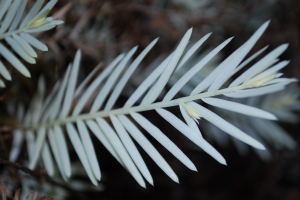Listen to the QUEST radio story Albino Redwoods: Ghosts of the Forest.
“Did you see it?”
On the day I visited Henry Cowell Redwoods State Park, just north of Santa Cruz, Dave Kuty pointed to a small white shrub, sprouted from the base of a normal-looking redwood tree. Had he not pointed it out to me, I’d have walked right by. Kuty says that’s pretty typical.
“It’s not particularly tall. It’s not particularly big. And so it could look dead,” he says.
Until you get up close. Albino redwood trees lack chlorophyll. Their needles are limp and waxy. They're the exact color of a glow-in-the-dark star you'd find in a kid’s bedroom.
While no one really knows for sure, albino redwoods may be extremely rare. Kuty says there may be as few as 25 in the in the world, all scattered between Humboldt County and Big Sur. Eight of them live here, at Henry Cowell park. It’s the largest known concentration of albino redwoods in the world.
The Mystery
“Most of the things that redwoods do have a purpose, and that is to keep the organism alive,” says Sandy Lydon, an author and retired professor of history at Cabrillo College.
He says albino redwoods break that rule. Without chlorophyll, they can’t convert sunlight into energy. The only reason they survive at all is because they are sprouts from an adult tree, connected at the root. So, for their entire lives, they suck energy from that mother tree.
They’re parasites,” says Lydon. “They’re freeloaders. They’re not contributing a damn thing to the host tree. Nothing.”
Eventually, the mother tree will cut ties to the albino sprout, and it’ll die. But that might take a hundred years, or more. And no one knows why.
“They’re mysterious.” Says Lydon. “And that’s what makes them so cool.”
A Genetic Advantage
Here’s what we do know: Albino redwoods – even though they appear to be useless – are a symptom of something very powerful in these trees, something that State Park docent Dave Kuty says is key to the success of the entire coast redwood species.
“Redwoods are hexaploid,” he says. “They have six genes per trait, as opposed to the two that we have.”
Hexaploid means that coast redwoods have six sets of chromosomes – those DNA instructions that tell cells what to do. Genetically, that means they’re playing with a much bigger deck of cards than we are. There are countless more combinations to play with, countless ways that a young tree can be just slightly different than its parents.
Kuty says the ability to change their genes so readily makes coast redwoods one of the most adaptable trees on earth. Every time a sprout comes up with slightly different genes, it’s kind of like an experiment. If it works, that tree might set the course for the redwoods of the future.
“They can develop resistance to fungi,” says Kuty. “They can develop resistance to viruses. They can develop better growth patterns.”
And sometimes, they can develop a trait that’s of absolutely no use to them at all, an evolutionary dead end. Albinos are an example of just that.
“They probably aren’t a particularly good modification, from the perspective of the health of the forest,” says Kuty, “but they demonstrate there’s a lot of experimentation going on.”
Living on Redwood Time
Here's something else that albino redwoods illustrate: Time, or, rather, time from the perspective of a redwood tree.
To demonstrate, Kuty points to a redwood branch the thickness of a wine barrel, lying on the ground. He says a few years ago, he and others here ran tests to see how old this branch was.
Preliminary data found the branch to be about 500 years old, as old as the Mona Lisa. The tree it fell off of could be as many as two thousand years old.
Five hundred years seems old to us, says Kuty, but to the tree it came from, it’s nothing, “just a disposable branch.”
So, back to albino redwoods. To us, a hundred years may seem like a long time for a mother tree to keep feeding her useless, parasitic albino offspring. But to a redwood, says Kuty, it’s just a blink of an eye.
Hidden Treasures
At Henry Cowell Redwood Park, just a few of the albino trees are labeled. That’s intentional, says Sandy Lydon. He says when he gives tours of this park, he takes careful note of the kinds of visitors he’s taking around.
“I tell them ‘if I don't show you an albino redwood today, it means you’ve failed as a group.’ You need to be an evolved human to be trusted with the information,” he says.
So consider it a complement that Lydon says it's ok if I give you a hint: Listen for the train whistle.
37.0440253 -122.0712299
 There may be as few as 25 albino redwood trees in the world.
There may be as few as 25 albino redwood trees in the world.